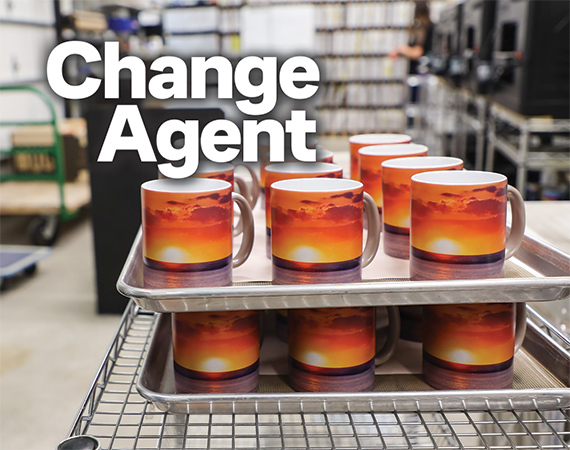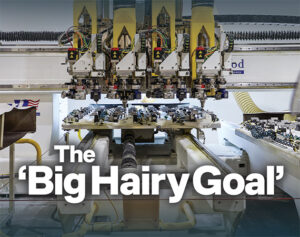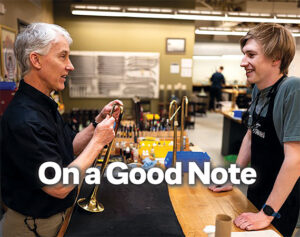At first glance, Mug Experience seems only to print logos on black mugs in a small manufacturing and office space tucked behind the founders’ house in Holdingford, Minn. Even the area surrounding the company feels modest and nondescript — there’s a cornfield across the gravel road, a stately church within walking distance, and a trampoline for the kids in the backyard. The town’s biggest claim to fame is that it’s the “gateway to Lake Wobegon,” a place that doesn’t even exist. The company doesn’t even have a sign to mark its location.
Yet the best magic tricks begin by letting the audience underestimate the simplicity of what’s really going on.
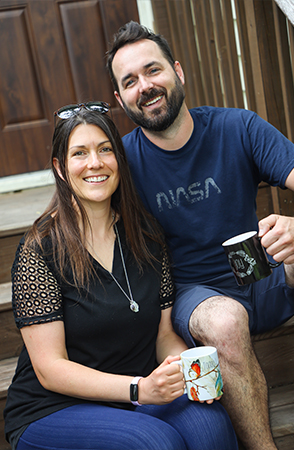
Those black mugs aren’t ho-hum corporate giveaways; they’re color-changing marvels that reveal often incredible scenes when filled with hot water. What was once plain becomes a vista filled with the aurora borealis for an Alaskan resort, or a raging stream filled with blueberries and a whitewater-rafting bear for a tea company, or a quiet morning lake scene bringing calm to customers at a local coffee shop.
The company can print literally any image on a mug that’s designed to hide those graphics until heat radiates from inside the cup — and thanks to two passionate founders, a dedicated team, and some wisdom from business advisors, Mug Experience is poised to do the same. As the company heats up, its true colors are just beginning to show.
Finding their pumpkin
The path toward the manufacturing facility in Holdingford had numerous twists and turns before it became Mug Experience in 2021.
Ben and Holly Torrens met in a physics class at North Dakota State University, both as electrical engineering majors who graduated in 2004. After getting married, they moved to Iowa and took jobs at the same company but always planned to return to the Holdingford area, where Holly had grown up. When her sister had a baby, the couple set that plan in motion, and Ben landed at a ballistics design firm in the Twin Cities, designing large-scale parachutes for planes and rockets, while Holly did engineering contract work from home.
In 2008, the ballistics firm was struggling in the midst of the housing crash and subsequent recession, so they asked for volunteers before doing layoffs. Since Ben had been yearning to start his own business, he stepped up. It seemed like a solid idea — until Holly got laid off three days later.
“We’d been writing down all these ideas of directions we could go with different businesses, and then suddenly we were both out of work,” Holly says. “It was a catalyst for us saying, well, now let’s try every idea and see what sticks.”
What resulted was a flurry of endeavors covering everything from web design to gift shop items. Ben enjoyed welding and had created sculptures for family celebrations — like two people holding a baby for when Holly’s nephew was born. Based on the enthusiasm for a kneeling sculpture he made, they crafted porcelain angel figures that could hold prayer cards. That was the idea that took off, and they started down the path of becoming a gift manufacturer.
“We were in full entrepreneurial mode because people seemed to like what we were making,” Ben says. “The underlying idea behind everything was to encourage and inspire people. When we were doing engineer work, we both felt disconnected, like we weren’t affecting anyone directly. You send out a project, but you don’t have the sense that someone is going to feel joy. So, we were trying to pivot toward that, but we just had so much going on.”
Then, the pair had a new idea to create color-changing mugs. They had their first designs ready just in time to help Holly’s grandmother celebrate a milestone birthday — they selected one for her with a night sky when the mug is cool and a sunrise when hot liquid is poured into it. The mug also featured a Saint Augustine quote: “Faith is to believe what you do not see.”
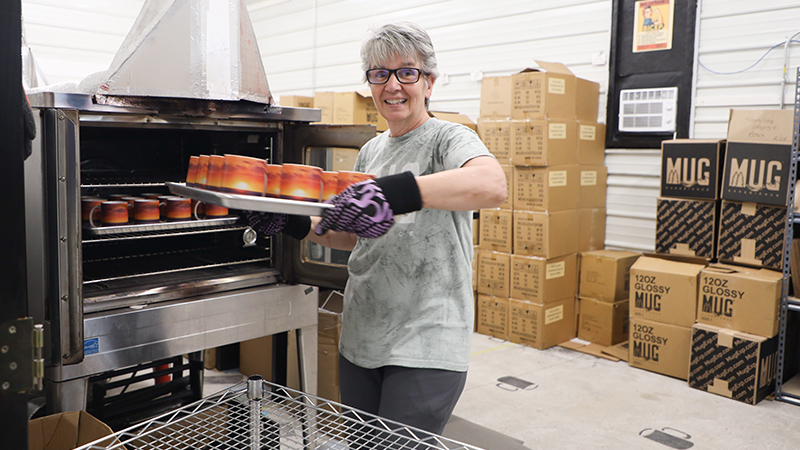
The family reaction to the changing colors was so striking that Ben and Holly knew they were on to something.
“We really got to witness the emotion of seeing the mug change, and that’s just what we wanted,” Holly recalls. “We wanted everyone to have that feeling.” After a year that was productive but resulted in negative profitability, Ben reached out to Eric Sparrow, owner of Milkhouse Candle in Iowa, for advice — then drove to his facility the next day. Sparrow shared some wisdom and recommended a book, The Pumpkin Plan, centering on business growth.
Written by Mike Michalowicz, the book uses the analogy of a pumpkin vine to advise entrepreneurs about focus. To grow a prize-winning pumpkin, you can’t let every single pumpkin try to thrive; the more you prune and become selective, the more energy will flow to the one that’s chosen.
The reaction to that first mug — and realizing that 80% of their revenue came from that product line — made the pumpkin idea compelling. That led to Ben and Holly finally pruning all those ideas down to one winner. “We loved all our other vines and pumpkins, but we realized we’d never have success spreading ourselves out like that,” Ben says. “It was really difficult to give up the other projects but also a relief to have a single focus that could take us to the next step, which was establishing a business and seeing growth. We had to start fertilizing the pumpkin.”
Creating better flow
After pruning all other product offerings, that freed up space in their manufacturing and production facility, which allowed them to put full focus on the color-changing mugs. A year later, they implemented a system that allowed clients to customize the mugs. That option took off, causing the company to develop new design tools and artwork applications.
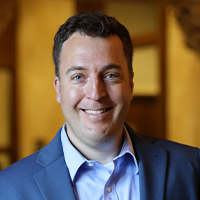
Continuously improving printing and automation tools, they decided to purchase a very large printer for customized boxes, but while the machine provided much higher quality, the production speed was significantly reduced. They found themselves unable to deliver on production expectations, which is what brought them to meet with Dawn Loberg and Ryan Steinert, two consultants from Enterprise Minnesota.
That’s when they discovered their streamlined processes weren’t so efficient after all. And the huge, expensive, space-consuming printer? Not worth the investment.
“Ryan simply showed us how often we touched a mug in the process from printing to shipping, and it was 47 times,” Ben says. “He also detailed how people moved around the work floor during the day, and it looked like spaghetti. There was just no flow at all.”
Because of that, they cut a hole in a wall and created a production loop that meant mugs were handled far fewer times in the process, and that also solved the issue of employee movement. At every step of the way, the duo was eager to implement suggestions because they saw changes almost immediately.
“Ben and Holly are electrical engineers who are very familiar with continuous improvement,” Loberg says. “They were not trained in manufacturing processes, but they’re like sponges; they’re very open-minded and willing to try anything, so they learned so much from Ryan.”
Although the two owners made significant changes to their workflow and equipment, they also looked at more modest shifts they could implement as well, and that was another major ingredient for their success, according to Steinert.
“They focused on consistent, small changes they could do every day,” he says. “A lot of manufacturers get caught up in wanting to buy improvement through large equipment, software, or automation, and they fail to realize the full, expected results. The owners and employees at Mug Experience have become really good at making small improvements to their processes that yield large results.”
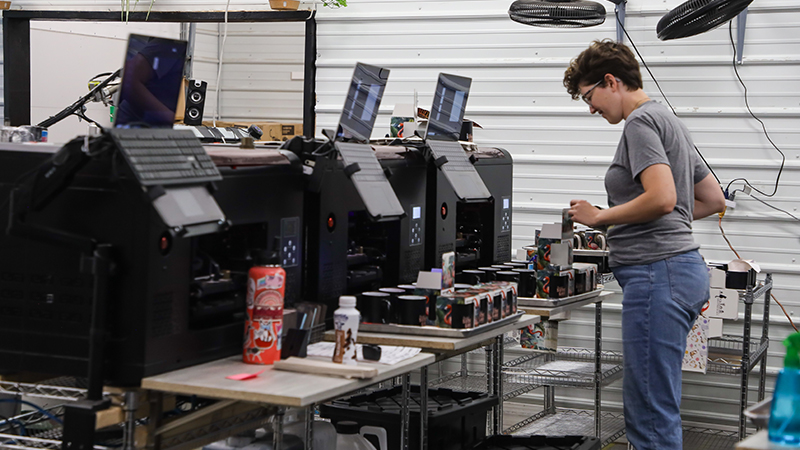
Collaboration as a growth driver
Another differentiator for Mug Experience is buy-in from team members. Even with a small employee group, empowerment isn’t always a given, but Ben and Holly recognize the benefits of supporting employee needs. Notably, there isn’t a small break room or just a table off in a corner with a mini-fridge available — instead, the couple bought a small, cabin-like house that was relocated onto the property as the employee hangout. It boasts an upstairs library, comfy seats, plenty of snacks, and a view of the woods.
They’ve also implemented a process that formalizes employee feedback, which has gone a long way toward prompting ideas that get put into action.
“Each employee is encouraged to contribute ideas, work on special projects, and take full ownership of their position and the business success,” Steinert says. “They win together.”
The company displays its core values on a poster in the middle of the production floor: balance and well-being; innovation and growth; collaboration; enthusiasm and excellence; positive impact. Next to that is a board filled with notes that call out specific employees who have made contributions to one of these values that week.
Employees are encouraged to share their concerns and improvement ideas, and there’s also an anonymous feedback system along with quarterly surveys. When the team decides there’s an idea that might be worth implementing, they move with remarkable speed, according to Steinert.
“When there are ideas that just make sense, the team moves forward right away,” he says. “They have a bunch of pilot projects running all the time that may not be perfect but are put in place and being tested. They are constantly in the ‘plan, do, check, act’ cycle of improvement. For example, during the facility layout project, the team came up with an optimal layout option that required walls to be knocked down, electrical and ducting to be moved, and their entire flow of production to be rearranged. They picked a couple days and just did it all.”
Small ideas are just as important as large ones, Ben says. For example, finished boxes were once put on the lower shelf of a cart, which required bending down to retrieve them. Having this happen occasionally isn’t much of a productivity killer, but when this happens many times a day, it can slow down workflow and increase the risk of overuse injuries. An employee suggested creating special hooks on the carts by using the 3D printer to create what they needed. Three employees worked on different design ideas before a winner was chosen, and it was implemented within hours of being suggested. The result is exactly what was needed: much less bending and time saved.
“Ben and Holly understand that continuous improvement starts with people, and that’s why they invest so heavily in their employees,” Loberg says. “That’s a bit rare in such a small company, but it’s why they’re growing and making smart decisions.” Their openness to applying the concepts they learned from Steinert and employees’ ideas had immediate business results, she adds. By streamlining workflow, they avoided the cost of a new building while increasing their revenue by 50% within the current facility.
“There is no doubt that they will continue investing in their people and processes to create a sound foundation for future growth,” Loberg says.
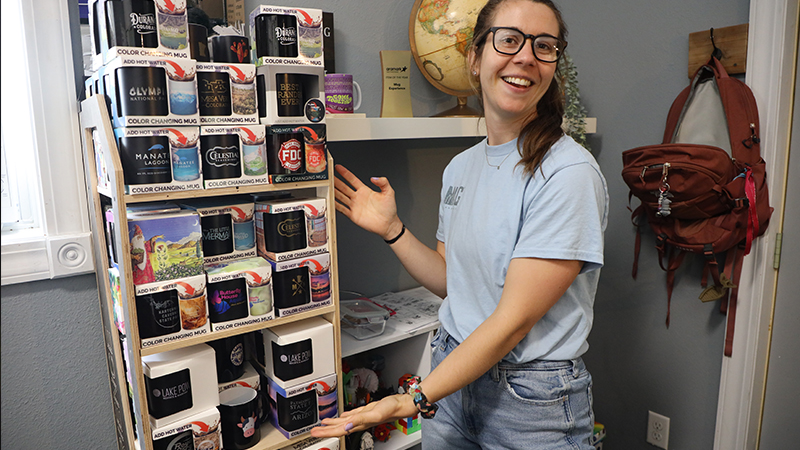
Looking ahead
Although Mug Experience started as a B2B enterprise and still has that as its customer base, the refinement of existing technology has led them to explore moving into the B2C arena as well. Right now, they’re beta testing a way for an individual to come onto their site and upload a photo that can be turned into a single mug.
“We weren’t able to do that before because we had inconsistent output and limited production capability, so that meant we could only do larger orders,” Ben says. “Then, after working with Enterprise Minnesota, we were able to solve those issues in a meaningful way and that gave us the confidence not only to work with bigger accounts but also to grow into the B2C space.”
One of those larger accounts, for example, is Aramark — they use Mug Experience to create mugs that go into National Park gift shops and awarded them “2024 item of the year.” Other customers include Disney, NASA, Caesars Casino, and Celestial Seasonings, as well as smaller gift shops and resorts around the country. Already, one wall of the production space is stacked high with mugs waiting to be applied with custom designs. Adding individual orders to this already bustling space will be quite a trick, they believe, but one worth trying.
“This should be a wild adventure, but we’ve never shied away from taking the next step,” Ben says. “We are growing that pumpkin, but more than that, we’re still connected to that original mission of making something that people feel excited about, that brings them joy. That feels like magic.”
Return to the Fall 2025 issue of Enterprise Minnesota® magazine.
